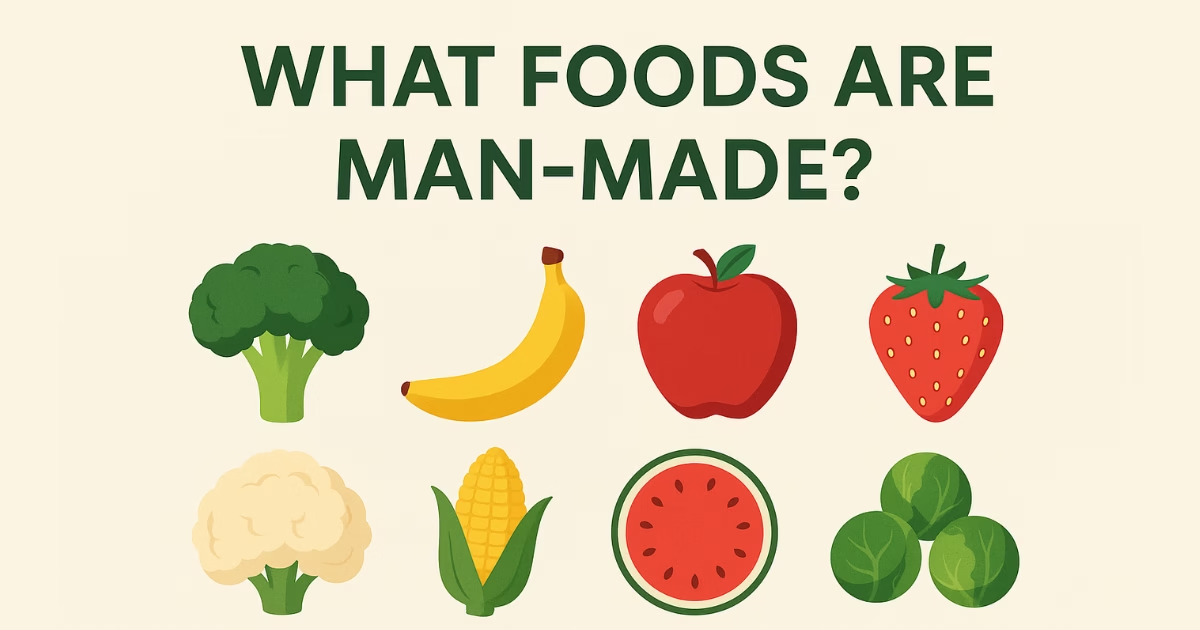When you walk through the produce aisle at your local grocery store, everything might seem fresh and natural — but the truth is, many of those foods didn’t grow that way in the wild. Over time, humans have altered various fruits, vegetables, and grains through selective breeding, hybridization, and genetic modifications. These changes weren’t random; they were done to improve taste, size, color, or shelf life. Some of your favorite foods are actually the result of centuries of human intervention. So, what foods are man-made, and how did they come to be? From bananas to broccoli, a surprising number of the foods we eat daily are carefully engineered versions of their wild ancestors. Understanding how these foods evolved can help you make smarter choices — and maybe even appreciate your dinner plate a little more.
What Foods Are Man-Made? A Surprising Breakdown
It might sound strange, but “man-made” doesn’t mean lab-grown or synthetic in all cases. In fact, most man-made foods were created through natural processes — just guided by human hands. Long before we had modern science, farmers were crossbreeding plants to grow crops that were sweeter, larger, or more resistant to disease.
For example, ancient corn was barely edible. It looked more like a dry grass stalk than the golden kernels we enjoy today. Likewise, wild bananas were full of hard seeds, and strawberries used to be tiny and sour.
So, what foods are man-made in this context? They’re the everyday fruits and veggies we think of as “normal” today — but their current forms are the product of thousands of years of innovation. Next, let’s take a closer look at some vegetables that didn’t start out the way they look now.Vegetables You Didn’t Know Were Man-Made
Some of the healthiest vegetables in your diet are actually the result of human innovation. Many were created through selective breeding — a process where farmers picked and planted only the best-looking or best-tasting crops, generation after generation.
Broccoli
Believe it or not, broccoli is entirely man-made. It was developed from wild cabbage in Italy over 2,000 years ago. Farmers bred the plant for its thick, edible flower buds. The result? The crunchy, green florets we eat today.
Cauliflower
Like broccoli, cauliflower comes from wild cabbage. It was selectively bred to form a tight, white head instead of green buds. Its unique shape and texture are thanks to human intervention.
Brussels Sprouts
These little green orbs may look different, but they’re also members of the cabbage family. Farmers bred them for size and shape.
Kale & Cabbage
All of these — kale, cabbage, cauliflower, broccoli, and Brussels sprouts — share a common ancestor. Humans shaped them into distinct vegetables by emphasizing different traits over time.
It’s mind-blowing, right? You might have thought these were separate species, but they’re really just siblings in disguise — all engineered by people.
Man-Made Fruits Created by Humans
When it comes to fruit, nature gave us the foundation, but humans polished the final product. Many popular fruits were too bitter, small, or seedy to be widely eaten in their original form.
Bananas
Wild bananas were packed with seeds and barely edible. The bananas we eat today are a result of crossbreeding two wild varieties. Now they’re soft, sweet, and seedless — but they wouldn’t exist without human help.
Strawberries
The modern strawberry is a hybrid. It was created by combining two wild species from North and South America. Early strawberries were small and sour, but thanks to selective breeding, today’s versions are large and sweet.
Apples
Wild apples were nothing like the juicy snacks we know today. They were often small and bitter. Humans bred them for sweetness, color, and crunch.
Watermelons
Ancient watermelons were round, pale, and not very sweet. Selective breeding gave us the juicy, red, seedless melons that scream summer today.
Grapefruit
This citrus fruit is a hybrid of a sweet orange and a pomelo. It was first discovered in the Caribbean in the 18th century — by accident! But it’s now a breakfast staple in many households.
Grains and Crops That Are Human-Made
Grains have been essential to civilization — and we’ve shaped them just as much as they’ve shaped us.
Corn
Corn started as a wild grass called teosinte. It was tiny and tough. Through careful breeding, humans transformed it into the sweet, plump corn we eat today.
Wheat
Modern wheat is a hybrid of multiple grass species. It was developed to improve baking properties and resistance to harsh environments. It’s now one of the world’s most important crops.
Rice
Though rice exists in wild forms, the type we eat has been carefully cultivated over generations to produce soft, flavorful grains. It’s been shaped for drought resistance and better taste.
Triticale
This one’s a true man-made crop — a cross between wheat and rye. It’s used for livestock feed and sometimes for human food. It was made to combine the productivity of wheat with rye’s hardiness.
Processed & Synthetic Foods That Are Entirely Man-Made
Now let’s talk about foods that didn’t exist in any form before humans made them from scratch — often in a lab or factory.
Artificial Sweeteners
Things like aspartame and sucralose are made by scientists to provide sweetness without calories. You’ll find them in diet sodas and sugar-free gum.
Margarine
Margarine is a butter substitute created using vegetable oils. It was invented in the 1800s and is now widely used in baking and cooking.
Imitation Meats
Brands like Beyond Meat and Impossible Foods have created plant-based “meat” products that look, cook, and taste like the real thing — but they’re made using science, not farms.
Flavor Enhancers
Monosodium glutamate (MSG) and other additives were created to boost flavor. While controversial at times, they are safe when used in moderation.
Why Were These Foods Created?
So, why go through all the trouble to make these foods? There are actually some very practical reasons:
- Taste: People prefer sweet fruits, tender vegetables, and flavorful grains.
- Shelf Life: Some man-made foods last longer before spoiling.
- Size & Yield: Bigger produce means more food per harvest.
- Pest Resistance: Hybrid and modified crops can survive harsh conditions.
- Convenience: Seedless fruits are easier to eat and enjoy.
Humans have always aimed to make food more enjoyable and easier to grow. It’s all about efficiency and taste.
Is Genetically Modified Food the Same as Man-Made?
Not always. It’s important to know the difference between man-made foods and genetically modified organisms (GMOs).
- Man-made foods are usually the result of selective breeding or hybridization.
- GMOs involve direct changes to DNA in a lab, like adding genes from other species.
While GMOs get a lot of attention, most man-made foods aren’t genetically engineered — they’ve just been improved through generations of careful cultivation.
GMOs are typically found in:
- Corn
- Soybeans
- Sugar beets
- Papaya (in some countries)
It’s worth noting that many studies show GMOs are safe, but opinions vary based on personal values and regional regulations.
Natural vs Man-Made: Should You Be Concerned?
The term “man-made” often sounds negative, but it doesn’t have to be. Many man-made foods are just enhanced versions of natural ones. They’re not artificial or fake — they’re just optimized.
For example:
- A wild banana is natural, but not very tasty.
- A modern banana is man-made, but healthier and more enjoyable.
If you’re buying whole fruits and vegetables at the store — even if they’re man-made — you’re still making good dietary choices. The key is moderation and knowledge.
So no, you don’t need to avoid man-made foods. You just need to understand them.
Also Read: List of Non Man-Made Fruits and Vegetables You Should Know
Final Thoughts: Embracing Food Evolution
From ancient farms to modern science labs, humans have shaped the food we eat. Asking what foods are man-made is really about understanding how much effort went into making food better, safer, and tastier.
While “natural” may sound better, remember: many “man-made” foods have fed the world, saved crops from disease, and even reduced food waste.
So next time you bite into a sweet strawberry or enjoy corn on the cob, just know — it’s not fake. It’s food, evolved.
FAQs: What Foods Are Man-Made?
Q1: Are man-made foods safe to eat?
Yes, most are created through safe methods like selective breeding. GMOs are also considered safe by most food authorities.
Q2: What are the healthiest man-made foods?
Fruits like bananas, apples, and strawberries — all man-made — are full of vitamins, fiber, and antioxidants.
Q3: Is organic food always natural?
Not necessarily. Organic produce can also be man-made through breeding. It just avoids synthetic pesticides or fertilizers.
Q4: How do I know if a food is genetically modified?
Check the label. In some countries, GMOs must be disclosed. You can also research common GMO crops.
Q5: Are there any completely natural foods left?
Yes, but they’re rare. Most common foods have been altered at some point. Wild foods like certain berries or mushrooms may still be natural.

Hi, I’m Shafy Ali – a curious mind and passionate writer at Celiac Magazine. I cover a little bit of everything, from everyday tips and how-tos to deeper dives into topics that spark conversation. I enjoy turning research into readable, relatable content that informs and inspires. Whatever the subject, I aim to keep it clear, engaging, and genuinely useful.

